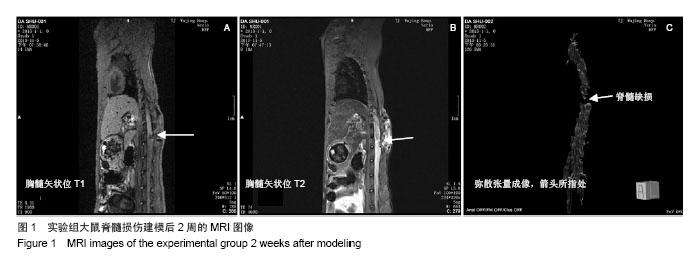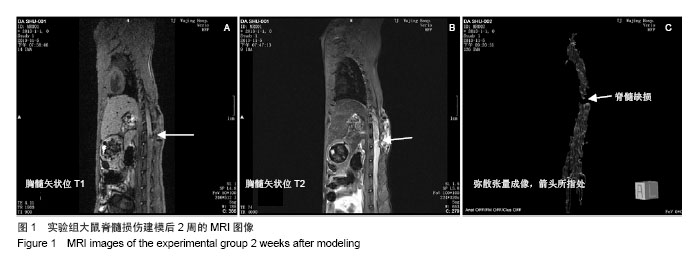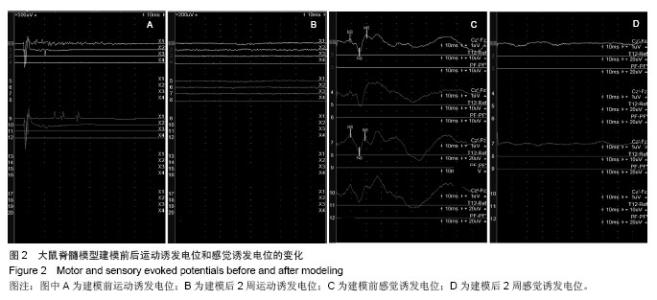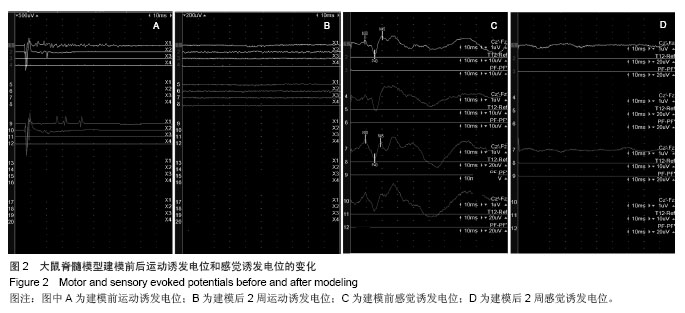| [1]李一帆,陈东,张大威.急性大鼠脊髓损伤Allen’s法模型的改良及电生理评价[J].中国实验诊断学,2010,14(8):1169-1172.
[2]王云,王其平,刘春风.脊髓损伤模型大鼠神经行为与脊髓病理变化的相关性[J].中华行为医学与脑科学杂志,2013,22(5):391- 393.
[3]Yoshida Y, Kataoka H, Kanchiku T, et al. Transection method for shortening the rat spine and spinal cord. Exp Ther Med. 2013;5(2):384-388.
[4]尹文化,金大地,鲁凯伍.大鼠脊髓全横断损伤模型标准化的初步探索[J].中国临床解剖学杂志,2008,26(6):647-651.
[5]曾洪武,王培军.磁共振扩散加权与弥散张量成像原理分析及比较[J].中国医学影像技术,2005,21(12):1945-1947.
[6]Wieshmann UC, Symms MR, Parker GJ, et al. Diffusion tensor imaging demonstrates deviation of fibres in normal appearing white matter adjacent to a brain tumour. J Neurol Neurosurg Psychiatry. 2000;68(4):501-503.
[7]高银峰,陈雪,王秀斌. 3.0T磁共振扫描仪对大鼠胸髓完全损伤模型成像的研究[J].交通医学,2010,24(1):1-3.
[8]王国毓,贺西京,袁普卫.嗅鞘细胞移植对脊髓损伤大鼠诱发电位的影响[J].中国组织工程研究与临床康复,2007,11(3):505-508.
[9]Wang J, Guo G, Wang W, et al. Effect of Methylprednisolone and Edaravone administration on spinal cord injury. Eur Rev Med Pharmacol Sci. 2013;17(20):2766-2772.
[10]Chen MH, Ren QX, Yang WF, et al. Influences of HIF-lα on Bax/Bcl-2 and VEGF expressions in rats with spinal cord injury. Int J Clin Exp Pathol. 2013;6(11):2312-2322.
[11]Bang WS, Kim KT, Cho DC, et al. Valproic Acid Increases Expression of Neuronal Stem/Progenitor Cell in Spinal Cord Injury. J Korean Neurosurg Soc. 2013;54(1):8-13.
[12]Théaudin M, Saliou G, Ducot B, et al. Short-term evolution of spinal cord damage in multiple sclerosis: a diffusion tensor MRI study. Neuroradiology. 2012;54(10):1171-1178.
[13]Mulcahey MJ, Samdani A, Gaughan J, et al. Diffusion tensor imaging in pediatric spinal cord injury: preliminary examination of reliability and clinical correlation. Spine (Phila Pa 1976). 2012;37(13):E797-803.
[14]Petersen JA, Wilm BJ, von Meyenburg J, et al. Chronic cervical spinal cord injury: DTI correlates with clinical and electrophysiological measures. J Neurotrauma. 2012; 29(8): 1556-1566.
[15]Rao JS, Zhao C, Yang ZY, et al. Diffusion tensor tractography of residual fibers in traumatic spinal cord injury: a pilot study. J Neuroradiol. 2013;40(3):181-186.
[16]Konomi T, Fujiyoshi K, Hikishima K, et al. Conditions for quantitative evaluation of injured spinal cord by in vivo diffusion tensor imaging and tractography: preclinical longitudinal study in common marmosets. Neuroimage. 2012; 63(4):1841-1853.
[17]刘雷,裴福兴.脊髓损伤模型制备及评价的研究进展[J].中国康复医学杂志,2004,19(12):949-951.
[18]Kim JH, Song SK, Burke DA, et al. Comprehensive locomotor outcomes correlate to hyperacute diffusion tensor measures after spinal cord injury in the adult rat. Exp Neurol. 2012; 235(1): 188-196.
[19]Mondragon-Lozano R, Diaz-Ruiz A, Ríos C, et al. Feasibility of in vivo quantitative magnetic resonance imaging with diffusion weighted imaging, T2-weighted relaxometry, and diffusion tensor imaging in a clinical 3 tesla magnetic resonance scanner for the acute traumatic spinal cord injury of rats: technical note. Spine (Phila Pa 1976). 2013;38(20): E1242-1249.
[20]高凌云,张玉芹,叶超群.诱发电位在监测细胞移植修复脊髓损伤大鼠中的应用[J].中国组织工程研究与临床康,2007,11(28): 5589-5593. |



